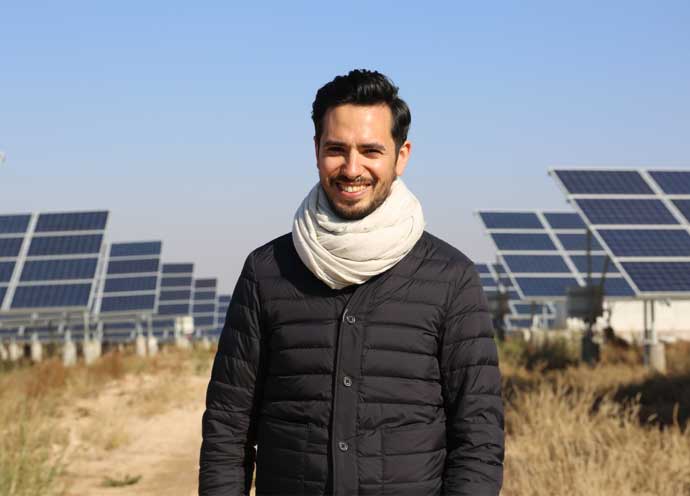World's fastest supercomputer to dragons: Tales from modern China

In the Tengger Desert of North West China, an epic battle between man and sand has raged for decades.
Back in the 1950s, when China built its first lifeline railway line though the desert, time and again the tracks were overwhelmed by drifting dunes.
Their chief weapon in the struggle? An unexpectedly mundane material: straw.
It’s still being used today. On an exposed, yellow Tengger dune, local man Xu Jianli and I hunch over shovels, surveying a stack of two-foot-long wheat-straw. How on earth can this frail stuff halt rolling dunes, I wonder? Xu Jianli scoops up an armful and briskly takes me through their simple desert-busting technique.

“Just get on with planting. Make sure it stands up proud.”
We’re filming with Mr Xu as part of a six-part series for BBC World News. I’m one of four presenters tasked with investigating lesser-known cultural, economic and technological stories from across this rapidly changing nation.
It’s a chance to unpack some of modern China’s diversity. And for me, as someone who’s studied and worked in and around the country for 20 years, shooting this story in the remote North West is a reminder of how little of this vast civilisation I really know.
Back on the dune, Mr Xu plunges his spade to wedge a double row of straw upright in the sand, creating a bristly windbreak. Repeat this enough times, he says, and you can stop sand in its tracks.
Sure enough, the next dune along is criss-crossed entirely, like a checkerboard of standing straw. With the wind thus blocked, a crust of soil can form over time – and plants and insects can return.
Although these days the Tengger Desert’s railway is lined with reclaimed green lungs of shrubs and trees, desertification remains a monumental problem for China. Estimates suggest between one sixth and one quarter of the country is now arid.
Expanding deserts threaten the livelihoods of a reported 400 million people, and fuel sandstorms which reach as far as Beijing and beyond. In 2015, residents in the capital complained of “Sand-ageddon”, when the worst storm in a decade turned skies yellow and caused air pollution to reach hazardous levels.
Thus, in a country China’s size, challenges are often of epic proportions. And so solutions, when decreed by the machinery of power, tend to be larger-than-life too.
A couple of hours’ drive from our Tengger location is the dusty provincial town Yanchi, the site of my next story. It’s in a barren part of one of China’s poorest provinces, Ningxia, with thin soils and low agricultural yields. But it is blessed with an abundance of one natural resource – sunshine.
China is hoping that the sun can help solve the problem of how to fuel its economy into the future. The country still overwhelmingly relies on coal power stations, with a devastating impact on air quality and health. But as the cost of solar power falls, policy is gradually turning towards renewable energy.

We arrive in Yanchi and unpack our drones, which struggle skyward in the cold December air. The footage they capture reveals what looks like a gigantic, space-age armadillo. In fact, it’s the world’s largest solar farm, an initiative by Chinese firm CMIG New Energy with government backing.
When we film it’s only half complete. When finished, 7.5 million solar panels will hug the rolling plains, generating 2 Gigawatts of energy: enough to power two million homes daily. A phalanx of photovoltaic panels slowly ripples around me as they follow the sun passing overhead.
Mr and Mrs Guo live in a village a short walk from the gates of the solar farm. They are sorghum farmers in their seventies, faces ruddied by years of hard work in the fields. I’m interested to know what they think of the glinting behemoth in their backyard. I wonder if she’ll talk about how incongruous it feels.
But no, instead she leads me behind her house and proudly shows me her own personal solar panels, also installed by the company.
In their shade, a few chickens peck at seeds on the dry earth. Having lived for years in an adobe house, suffering through bone-biting winters, she’s just pleased they now have abundant electricity.
This rapid change exemplifies what is happening all over the country. Elsewhere in the series, we explore the production of ice-wine made from frozen grapes in the sub-zero temperatures of Liaoning; take a walk around inside the world’s fastest supercomputer in Wuxi; and hang out with China’s young internet stars – the live-streamers making millions from online video.
But my favourite story takes us to the rugged South West, and the outskirts of Chongqing. It’s one of the most dramatically located cities in China, a dizzying urban landscape of glass, steel and neon threaded between green mountain peaks and perched atop a shoulder of land jutting into the Yangtze.
Chongqing is famed for its fiery hotpot, made more potent by what I call "numb nuts" – the fearsome Sichuan peppercorns which leave a fizzing numbness in your mouth.
As the crew gather to simmer meat and veg in the bubbling red broth, I notice our Chinese cameraman has a runny nose. “Never fear,” he says, “hot pot can cure everything!”
Sure enough, the next day he’s fighting fit. We set out for Chongqing’s Tongliang district to film a traditional art form with a different kind of fiery twist.
Our subject is the dragon – that most symbolic creature of the Chinese zodiac. Dragons were traditionally believed to control the rainfall, of vital importance to an agricultural society. And here in the hinterland of Chongqing, dragons are everywhere: on shop signs, in hotel names, in towering municipal sculptures, and in the all-conquering dragon dancing teams nurtured in the area’s schools.

It’s from within this region’s dense, misty hills that an acrobatic tradition has evolved to a whole new level, with the fire dragon dance.
Night is falling in Gaolou, a small country town within Tongliang.
We’re setting up at one end of the town square. Crowds of rowdy schoolchildren gather, eager to watch a foreign film crew at work. At each corner of the square is a stove, each containing a crucible of iron being fired to a precise temperature of 1400 degrees. Troupes of male dancers are stripping off their shirts and donning red pantaloons. The crowd is told to move back. The show is about to commence.
Two dancing dragons soar onstage. And with that, the pyrotechnics begin. From the stove beside me, one man ladles out a blob of molten iron and tosses it high into the air. A second performer then expertly smashes the burning blob mid-air with a spade – creating an immense cascade of white-hot sparks which falls like incandescent rain over the whole performance space.
It’s a spectacular sight. The night sky is ablaze with floating fire. And amongst the confusion, the dragons duck and weave.
As the crew films me describing the action, I try to dodge the falling embers. They scorch tiny holes in my hat, and one singes its way down my back. Meanwhile, the troupe in front of me dances bare-chested in the showers of fire, impervious to the pain.
You may have seen some dragon-dances in your time – but this one gets under the skin.
(Courtesy: The six-part series documentary is scheduled to air on BBC World News starting June 3 upto July 11 every Saturday and repeats on Sunday and Tuesday. On Saturdays it will air at 7am and 2pm; on Sundays at 8pm and on Tuesdays at 3pm.)

